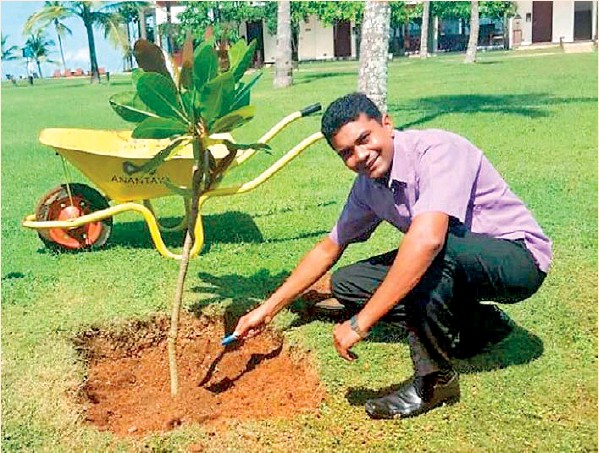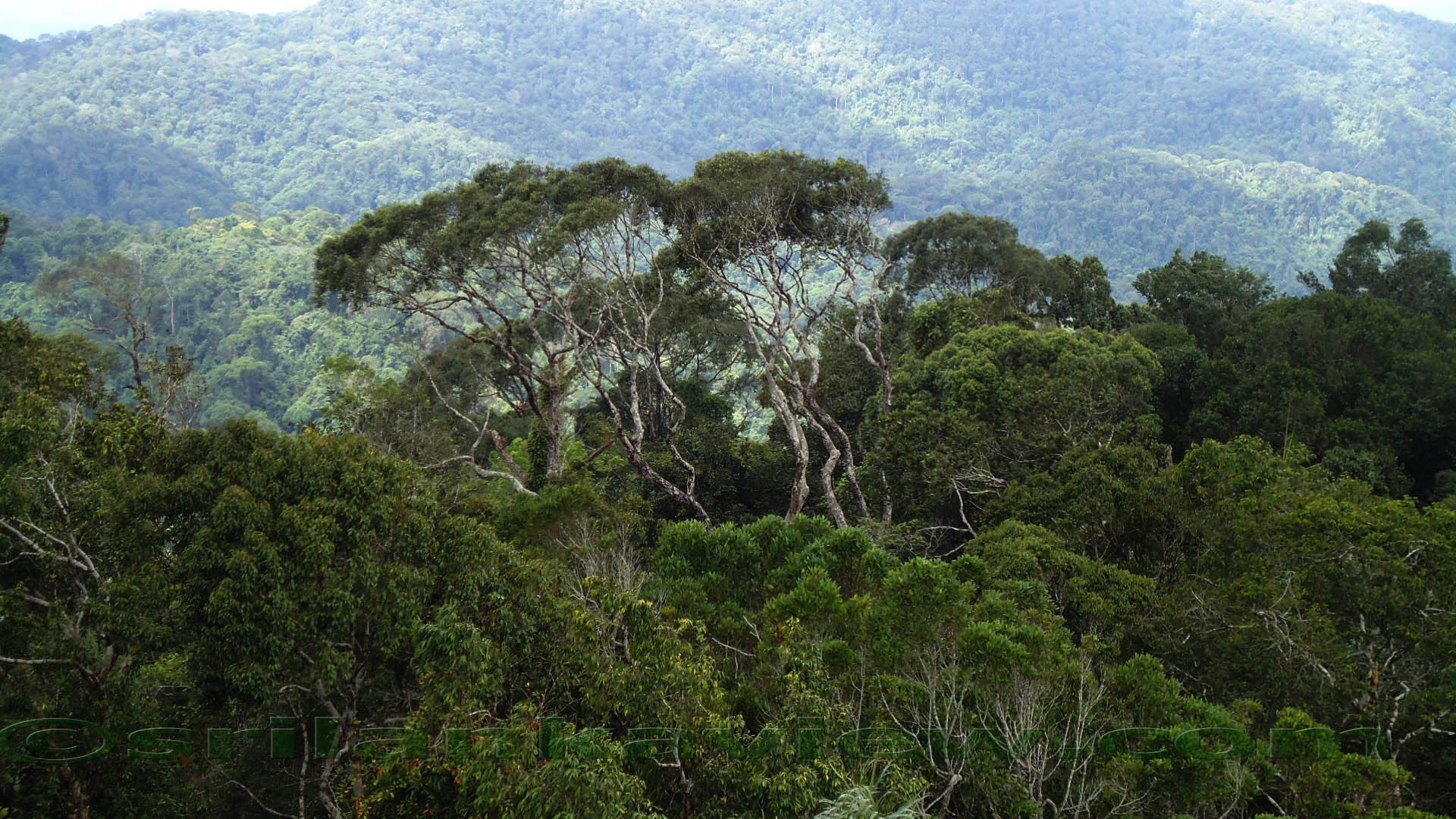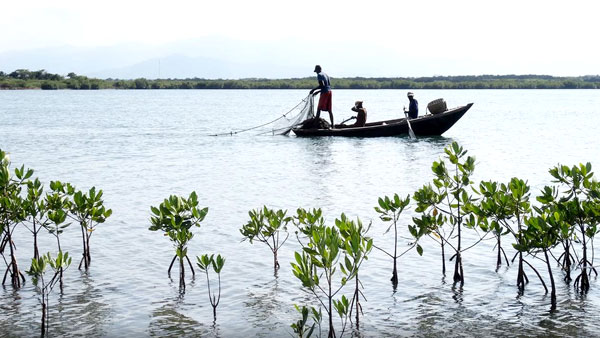
Anantaya launches green campaign
The Anantaya Resort chain of Laugfs Leisure Limited has yet again embarked on another green i nitiative as part of its sustainability efforts.
Renowned for its ‘eco luxury’ concept, Anantaya recently launched a tree planting drive at its Chilaw resort, as part of a broader campaign to strengthen its commitment towards the environment and community within which it operates. The initial tree planting drive took place along the road leading up to the Chilaw resort premises, adding a fresh touch of greenery to the surroundings. This initiative will be also rolled out at the newly built Anantaya Resort & Spa in Pasikudah, which is expected to be launched soon.
Anantaya will also be one of the first hotels to initiate eco tours in Sri Lanka, deploying eco-friendly vehicles consisting of electric and hybrid vehicles for excursions. Its resort in Chilaw will soon be geared to offer its guests with visits to the Anawilundawa Bird Sanctuary and Wilpattu National Park, both located in close proximity to the resort, in state-of-the-art electric sport utility vehicles (SUVS). Its environmentally friendly vehicle fleet will also be utilized for airport pickups and drops, as well as daily travel needs of its guests.
“Today environment concerns are mounting beyond imagination, with many adverse effects of environmental pollution felt all over the world. Present-day travellers are very much concerned about their environmental footprint through various product and service associations,” remarked Laugfs Leisure CEO Roshan R. Perera.
“Laugfs’ commitment to a sustainable future is ingrained in not just our approach to business but in also how we do business. The Anantaya Resort chain has also been following this philosophy from day one. Our ‘eco luxury’ concept at Anantaya Chilaw is a good example of this,” he further added.
The hotel architecture and landscape areas of Anantaya Resort & Spa i n Chilaw have been designed t o preserve t he surrounding natural environment, striking a fine balance between eco-friendliness and luxury. Many energy saving and conservation measures have been built into the design of the resort, with careful consideration given to functional details such as the type of air conditioning used, installation of solar panels wherever possible, use of natural light for public spaces and recycling of treated sewerage water for irrigation. This has helped Anantaya to achieve substantial savings in energy and water management, while preserving the natural beauty of the area.
The Anantaya luxury resort chain is owned and managed by Laugfs Leisure Limited, a subsidiary of Laugfs Gas PLC.
Source : 29-04-2016 Daily Mirror (Sri Lanka)

World Bank gives US$45mn to protect Sri Lanka’s natural habitat
The World Bank has approved a 45 million US dollar loan to help protect Sri Lanka’s natural habitats and resources from degradation and exploitation.
The money will also help improve the lives and livelihoods of neighboring communities, who suffer the most from natural resource loss and degradation, a statement said.
“Natural ecosystems in Sri Lanka provide clean water, food, medicine, carbon storage, recreation and habitats for local communities, wildlife and fisheries, and prevent floods and erosion,” said Francoise Clottes, World Bank Country Director for Sri Lanka and the Maldives.
“If well managed, these areas will benefit the national economy, spur Sri Lanka’s nature-based tourism potential, and help address local challenges brought on by poverty, decreased productivity and degradation of land and water, human-wildlife conflicts, and climate change.”
The Eco-systems Conservation and Management Project (ESCAMP) will benefit 15,000 residents; 30 percent among them women, with most belonging to marginalized groups, the bank said.
It will protect and foster the sustainable use of natural resources help create jobs and livelihoods.
Through the Department of Wildlife Conservations and Forest Department, the project will manage protected natural areas through improved landscape management, raise awareness and improve coordination on natural resource management among local authorities, and increase the quality of nature-based tourism.
“The project will improve the management and stewardship of protected areas and other biologically important locations throughout Sri Lanka,” said Darshani De Silva, Environment Specialist and Project Task Team. “It will help establish networks to protect ecosystems, maintain the population of endemic species, while promoting environmentally sound infrastructure development and visitor services to raise the quality and revenue potential of green tourism.”
The project also aligns with the government’s policies to expand forest cover in line with Sri Lanka’s conservation strategy ‘Punarudaya’. The project, to be done by the Ministry of Mahaweli Development and Environment and Ministry of Sustainable Development and Wildlife, will develop human-elephant co-existence mechanism and protect watersheds to boost agricultural productivity, the World Bank said.
“Over time, the project will reinforce the emerging strategy on Reducing Emissions from Deforestation and Forest Degradation as well as policies to promote sustainable water, agriculture and energy practices, while supporting social inclusion and resilience to climate and disaster risks.”
The loan is provided by the International Development Association – the World Bank’s concessionary lending arm –with a maturity of 25 years, including a 5 year grace period.
(Source : 28-04-2016 Economy Next. http://www.economynext.com/World_Bank_gives_US$45mn_to_protect_Sri_Lanka%E2%80%99s_natural_habitats-3-4832.html)

Agree to be Green
As many as 195 States were parties to the discussions in Paris on the COP 21 Agreement which was accepted in general by consensus. The Agreement will be deposited at the UN in New York and opened for one year for signature on April 22, 2016–Mother Earth Day. The Agreement will enter into force after 55 countries that account for at least 55% of global emissions have deposited their instruments of ratification
It was recently reported that Cabinet approval had been given for Science, Technology and Research Minister Susil Premajayantha to sign on behalf of the Sri Lankan government the Paris Agreement adopted by the Conference of The Parties (COP 21) to The United Nations Framework Convention on Climate Change UNFCCC) held in September 2015. It is understood that Cabinet approval was granted not for the mere signature of the treaty (which is not sufficient for the treaty to be applicable to Sri Lanka) but for the ratification of this Agreement by which Sri Lanka will be bound by the principles enunciated in the Agreement. Minister Premajayantha is to participate in the high level signature ceremony on April 22 at The Headquarters of the United Nations in New York.
As many as 195 States were parties to the discussions in Paris on the COP 21 Agreement which was accepted in general by consensus. The Agreement will be deposited at the UN in New York and opened for one year for signature on April 22, 2016–Mother Earth Day.
The Agreement will enter into force after 55 countries that account for at least 55% of global emissions have deposited their instruments of ratification. The overall aim of the Agreement is to maintain a global temperature rise in the 21st century to well below 2 degrees Celsius and to strive to limit the temperature increase even further to 1.5 degrees Celsius above pre-industrial levels, the lower level recognized as a buffer against worst case scenario impacts of climate change. Another important goal of the Agreement is to strengthen the capacity of States to effectively address and mitigate the impacts of climate change.
Article 2 of the Agreement stipulates that the Agreement aims to strengthen the global response to the threat of climate change, in the context of sustainable development and efforts to eradicate poverty, including by: holding the increase in the global average temperature to well below 2 °C above pre-industrial levels and to pursue efforts to limit the temperature increase to 1.5 °C above pre-industrial levels, recognizing that this would significantly reduce the risks and impacts of climate change; increasing the ability to adapt to the adverse impacts of climate change and foster climate resilience and low greenhouse gas emissions development, in a manner that does not threaten food production; and making finance flows consistent with a pathway towards low greenhouse gas emissions and climate-resilient development.
Article 2.2. is explicit in stating that the Agreement will be implemented to reflect equity and the principle of common but differentiated responsibilities and respective capabilities, in the light of different national circumstances.
The Agreement also recognizes the need to put in place appropriate financial tools in order to achieve the aforementioned ambitious goals with a view to enabling developing states to face the challenges of mitigating climate change at their own pace and in accordance with their own national objectives.
There was considerable hope that the agreement would truly promote sustainable development.
UN Secretary General Ban Ki-moon said: “We have entered a new era of global cooperation on one of the most complex issues ever to confront humanity.
For the first time, every country in the world has pledged to curb emissions, strengthen resilience and join in common cause to take common climate action. This is a resounding success for multilateralism.”
National climate action plans
The critical areas covered by the COP 21 Agreement are: mitigation – reducing emissions fast enough to achieve the temperature goal; a transparency system and global stock-take – accounting for climate action; adaptation – strengthening ability of countries to deal with climate impacts; loss and damage – strengthening ability to recover from climate impacts; and support – including finance, for nations to build clean, resilient futures. The Agreement espouses a long term direction that would enable States to reach a peak in their emissions as soon as possible and continue to submit national climate action plans that detail their future objectives to address climate change.
A UNFCCC Secretariat statement claims that, in the spirit of the Agreement, 188 countries have undertaken to contribute climate action plans in accordance with the new agreement, which is calculated to dramatically slow the pace of global greenhouse gas emissions. The basic philosophy of the Agreement is that future national plans will be no less ambitious than existing ones, which means these 188 climate action plans provide a firm floor and foundation for higher ambition. It has also introduced nationally determined contributions (NDCs) – updated plans for reducing greenhouse gas emissions – once every five years, which will regularly and consistently improve their strategy towards achieving their overall goals in the long-term.
The Agreement also provides for action to be taken even before 2020 where States are required to continue to engage in a process on mitigation opportunities and will put added focus on adaptation opportunities. Furthermore, since reaching the ambitious target of 1.5% below industrial levels would mean keeping at least 75% of the current flow of fossil fuels on the ground, and using renewable energy instead, States will raise climate finance up to $ 100 billion by 2020 that would assist developing countries to develop such energy resources. States will, in this regard, work towards defining a clear roadmap on ratcheting up climate finance to USD 100 billion by 2020 while also before 2025 setting a new goal on the provision of finance from the USD 100 billion floor.
A roadmap in this regard will be developed by States. There will also be put in place a robust transparency and accounting system that would allow for special circumstances and respective capabilities of States to be recognized and taken as part of the equation. Support and cooperation are the main themes of this philosophy. The Agreement also strengthens international cooperation on climate-safe technologies and building capacity in the developing world to address climate change.
Developing countries
All States are required to submit adaptation communications, in which they may detail their adaptation priorities, support needs and plans. There is also provision for developing countries to receive increased support for adaptation actions, for which there will be an assessment of the adequacy of this support that will be given. As already mentioned, the Agreement has incorporated a robust transparency framework for both action and support. The framework will provide clarity on countries’ mitigation and adaptation actions, as well as the provision of support. At the same time, it recognizes that Least Developed Countries and Small Island Developing States have special circumstances.
According to the UNFCCC Secretariat, the agreement includes a global stock-take starting in 2023 to assess the collective progress towards the goals of the agreement. The stock-take will be done every five years and the agreement includes a compliance mechanism, overseen by a committee of experts that operates in a non-punitive way.
From a technical standpoint, COP 21 addressed a number of issues which go to say that under the Kyoto Protocol – which is an international treaty which extends the 1992 United Nations Framework Convention on Climate Change (UNFCCC) that commits State Parties to reduce greenhouse gases emissions, based on the premise that (a) global warming exists and (b) man-made CO2 emissions have caused it – there is now a clear and transparent accounting method for carry-over credits for the second commitment period, creating a clear set of rules; and the first round of international assessment and review process (IAR) that was launched in 2014 was successfully completed. A number of technical and implementation issues related to the existing arrangements on technology, adaptation, action for climate empowerment and capacity building were also successfully concluded.
The Stern Review of October 2006 titled The Economics of Climate Change stated that if no action is taken to reduce emissions, the concentration of greenhouse gases in the atmosphere could reach double its pre-industrial level as early as 2035, virtually committing us to a global average temperature rise of over 2 degrees centigrade. In this context, Sri Lanka’s ratification of the Paris Agreement shows an abiding sense of responsibility and awareness on the part of the State.
Source :26-04-2016 Dailly News http://www.dailynews.lk/?q=2016/04/26/features/79789



